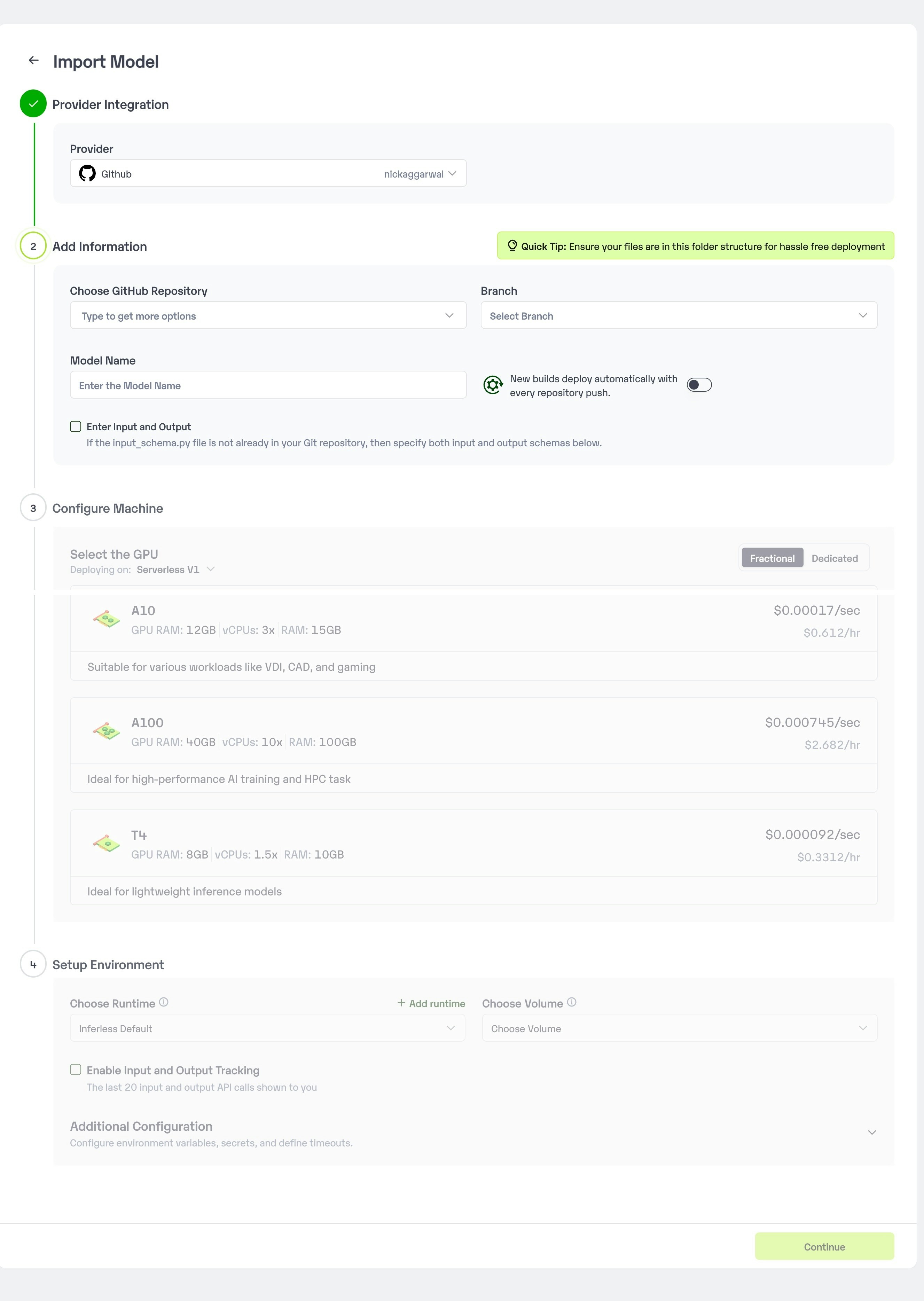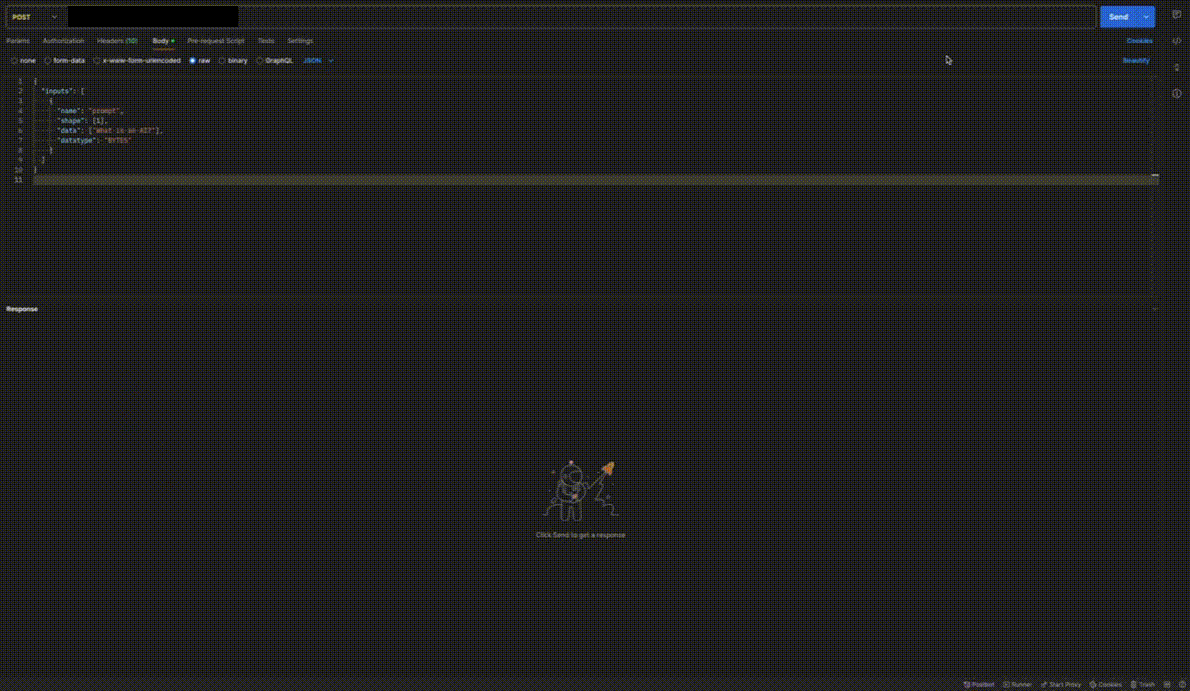HuggingFaceH4/ultrachat_200k dataset which is a filtered version of the UltraChat dataset from Huggingface.
For model quantization, we will load the model in a 4-bit format using bitsandbytes.
Finally, when deploying the model on Inferless, you can anticipate the following outcomes.
| Library | Inference Time | Cold Start Time | Tokens/Sec |
|---|---|---|---|
| vLLM | 1.63 sec | 13.30 sec | 78.65 |
Why finetuning?
Fine-tuning an LLM is a supervised learning process, and we will use Parameter Efficient Fine-Tuning (PEFT), which is an efficient form of instruction fine-tuning.Let’s get started:
Installing the Required Libraries
You need the following libraries for fine-tuning.Dataset Preprocessing
From theHuggingFaceH4/ultrachat_200k dataset, we will sample 10000 text conversations for a quick run.
We have formatted the data using ChatML as we want our model to follow a specific chat template (ChatML).
Finetuning the Llama-3
Now load the tokenizer and the model then quantize and prepare the model for finetuning in 4bit using bitsandbytes. Load and initialize the tokenizer with Hugging Face TransformersAutoTokenizer.
For ChatML support, we will use the setup_chat_format() function in trl. It will set up the chat_template of the tokenizer, add special tokens to the tokenizer and resize the model’s embedding layer to accommodate the new tokens.
Prepare the model for QLoRA training using the prepare_model_for_kbit_training().
SFTTrainer. The SFTTrainer is then created and used to start the fine-tuning process.
Let’s deploy the finetuned model on Inferless
Defining Dependencies
We are using the vLLM library, which boosts the inference speed of the LLM.Constructing the GitHub/GitLab Template
Now quickly construct the GitHub/GitLab template, this process is mandatory and make sure you don’t add any file namedmodel.py.
Create the class for inference
In the app.py we will define the class and import all the required functions-
def initialize: In this function, you will initialize your model and define anyvariablethat you want to use during inference. -
def infer: This function gets called for every request that you send. Here you can define all the steps that are required for the inference. You can also pass custom values for inference and pass it throughinputs(dict)parameter. -
def finalize: This function cleans up all the allocated memory.
Create the Input Schema
We have to create ainput_schema.py in your GitHub/Gitlab repository this will help us create the Input parameters. You can checkout our documentation on Input / Output Schema.
For this tutorial, we have defined a parameter prompt which is required during the API call. Now lets create the input_schema.py.
Creating the Custom Runtime
This is a mandatory step where we allow the users to upload their custom runtime through inferless-runtime-config.yaml.Test your model with Remote Run
You can use theinferless remote-run(installation guide here) command to test your model or any custom Python script in a remote GPU environment directly from your local machine. Make sure that you use Python3.10 for seamless experience.
Step 1: Add the Decorators and local entry point
To enable Remote Run, simply do the following:- Import the
inferlesslibrary and initializeCls(gpu="A100"). The available GPU options areT4,A10andA100. - Decorated the
initializeandinferfunctions with@app.loadand@app.inferrespectively. - Create the Local Entry Point by decorating a function (for example,
my_local_entry) with@inferless.local_entry_point. Within this function, instantiate your model class, convert any incoming parameters into aRequestObjectsobject, and invoke the model’sinfermethod.
Step 2: Run with Remote GPU
From your local terminal, navigate to the folder containing yourapp.py and your inferless-runtime-config.yaml and run:
--temperature, --max_tokens, etc.) as long as your code expects them in the inputs dictionary.
Method A: Deploying the model on Inferless Platform
Inferless supports multiple ways of importing your model. For this tutorial, we will use GitHub.Step 1: Login to the inferless dashboard can click on Import model button
Navigate to your desired workspace in Inferless and Click onAdd a custom model button that you see on the top right. An import wizard will open up.
Step 2: Follow the UI to complete the model Import
- Select the GitHub/GitLab Integration option to connect your source code repository with the deployment environment.
- Navigate to the specific GitHub repository that contains your model’s code. Here, you will need to identify and enter the name of the model you wish to import.
- Choose the appropriate type of machine that suits your model’s requirements. Additionally, specify the minimum and maximum number of replicas to define the scalability range for deploying your model.
- Optionally, you have the option to enable automatic build and deployment. This feature triggers a new deployment automatically whenever there is a new code push to your repository.
- If your model requires additional software packages, configure the Custom Runtime settings by including necessary pip or apt packages. Also, set up environment variables such as Inference Timeout, Container Concurrency, and Scale Down Timeout to tailor the runtime environment according to your needs.
- Wait for the validation process to complete, ensuring that all settings are correct and functional. Once validation is successful, click on the “Import” button to finalize the import of your model.

Step 3: Wait for the model build to complete usually takes ~5-10 minutes
Step 4: Use the APIs to call the model
Once the model is in ‘Active’ status you can click on the ‘API’ page to call the modelHere is the Demo:

Method B: Deploying the model on Inferless CLI
Inferless allows you to deploy your model using Inferless-CLI. Follow the steps to deploy using Inferless CLI.Clone the repository of the model
Let’s begin by cloning the model repository:Deploy the Model
To deploy the model using Inferless CLI, execute the following command:--gpu A100: Specifies the GPU type for deployment. Available options includeA10,A100, andT4.--runtime inferless-runtime-config.yaml: Defines the runtime configuration file. If not specified, the default Inferless runtime is used.